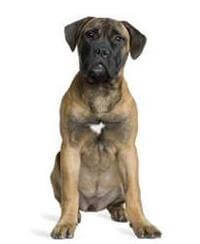Find products that match your dog’s needs

Do you want a dog that loves and adores you as well as your children? If yes, you need a Bullmastiff dog in your life. Not just a Bulldog or a Mastiff, these guys are the best of both breeds in one. You can train these beasts to be obedient and formidable guardians. Bullmastiffs welcome belly rubs, cuddles, and ear scratches.
Bullmastiffs love and crave their caregiver’s attention, so shower them with all you’ve got. After all, it is hard to miss 130 pounds of affection coming your way. While they do not need a lot of physical exercise, training is a must. It is to make sure that your living teddy bear is well-socialised with family members and other animals. They love snuggles and expect a lot of it, so get ready for the best time of your life.
Here’s everything you need to know about the Bullmastiff’s characteristics before you get one home:
Weight | 45 to 60 kg |
Height | 24 to 27 inches |
Lifespan | 7 to 9 years |
Coat | Single coat |
Bullmastiffs are known for their resting face, with their bulldog lineage appearing through wrinkles on their foreheads and their soft fur. This dog breed sports dense yet sleek short coats in different colours such as:
The most rare and unique coat colours found on a Bullmastiff are silver, merle, and grey.
While the English Mastiff and Bullmastiff are two completely different breeds, people get easily confused between the two because the latter is part English Mastiff. Here are some features you must look out for when trying to identify a purebred Bullmastiff:
A Bullmastiff’s temperament differs from what its appearance may suggest. Because of their large-breed physique, they may come off as intimidating and unwelcoming but that’s not the case. In fact, they are big babies who love cuddling and crave their caregiver’s attention. Yes, every pup is unique, but Bullmastiffs prefer to be all up in your business. They would prefer being in the same room as you, next to you, or even better– cuddling with you.
While it is great to have a dog that loves spending time with you, it does not happen automatically. Like any other working dogs or dogs in general, Bullmastiff dogs feel no fear around their caregivers after proper training and positive reinforcements. If you are planning to bring a Bullmastiff dog home, start training it as soon as it turns 10 weeks old.
Bullmastiffs are great family dogs, thanks to early socialisation. This breed may be loving and docile, but it is still a large breed, they need to learn how to practise good behaviour, even around visitors. They hate hearing a “no” so caregivers must be ready to put in some serious hours disciplining their Bullmastiffs.
Bullmastiffs should be started with their training as soon as they turn 10 weeks old. Since Bullmastiff dogs hate to hear “no” from their caregivers, this attitude can set them up for unfair expectations in the future. These large breed dogs can also get difficult to handle if they become aggressive. For reasons as such, it is crucial to train Bullmastiff dogs at a young age.
Obedience training is the way to go with Bullmastiffs. These large breed dogs are not especially active and don’t need to do any heavy physical activity. Keeping that in mind, training them is not such a task. Start with basic obedience training and teach simple commands such as “sit”, “stay”, “go”, and more. To ensure that your Bullmastiff stays motivated throughout its training sessions and does not get distracted, give it its favourite treats. Positive reinforcement goes a long way with these chonky beasts.
Socialisation training is extremely important for Bullmastiff dogs. They are great with children and make for excellent family dogs but they need to be socialised around other dogs. Start your Bullmastiff pup’s socialisation as soon as it turns 15-16 weeks old. This will help it stay friendly with others, making your job as a pet parent easier.
Here’s how you can care for your Bullmastiff dog:
All deep-chested, large dog breeds are susceptible to bloat. This condition can be deadly if not identified and treated in the early stages. Pet parents must educate themselves about this condition so that they can identify the signs and symptoms. Apart from bloat, the Bullmastiff dog breed is also susceptible to degenerative joint conditions and cancer. The best way to keep track of your floof’s well-being is to take it for regular check-ups so that your vet can screen your Bullmastiff dog for different diseases such as elbow and hip dysplasia, different heart conditions, and more.
A Bullmastiff does not need a lot of grooming but there are two things that you need to be aware of when sharing your space with it: flatulence and slobber. Since Bullmastiffs are flat-faced dogs, they drool a lot, and the way they eat causes noxious fumes. Your vet can help you figure out a way to keep your Bullmastiff dog’s mask folds clean and give you steps to keep its digestion in check.
Bullmastiffs don’t shed a lot generally but spring and fall season is when you will notice some shedding. Make sure to brush its fur with a soft-bristled brush. Because of their single coat, brushing is convenient, and you can do it every few days. Bullmastiffs don’t need a strict bathing schedule. Whenever you notice that your Bullmastiff is smelling not so great, give it a bath. Apart from that, trim its nails regularly, be consistent with teeth brushing to avoid any foul smell, and perform regular ear checks.
Bullmastiffs enjoy playtime and movement in general. Yes, every dog is different, and some might be sedentary, but this breed generally enjoys daily exercise. You can take it for brisk walks, play games like fetch, and more. If you take your Bullmastiff out to your yard for any physical activity, make sure to fence your yard. Fencing helps keep your doggo safe from any intrusions and from getting distracted and wandering off. Don’t over-exercise your Bullmastiffs, just keep it simple.
High-quality adult dog food is recommended for adult Bullmastiffs and large-breed puppy food is recommended for Bullmastiff puppies to ensure slow and steady growth. Puppies should be fed several small meals and adult Bullmastiff dogs should be fed two meals daily for good digestion. Because this breed is susceptible to bloat, exercising right before or after meals is a big no. They need to be kept lean, especially as puppies, since they grow very rapidly.
“Gamekeeper’s Night Dog” is what Bullmastiffs are famously referred to as. It is because this breed originates from England in the mid-1880s, helping gamekeepers on expansive country estates keep poachers away from stealing. These impressive canines were created to obtain a breed that is assertive, quick, and even-tempered. Their purpose was to track poachers and pin them down until the gamekeeper arrived.
Yes, Bullmastiffs can get along with other pets provided that they have been socialised since a young age. As soon as your Bullmastiff dog turns 15-16 weeks old, start its socialisation training.
A Bullmastiff is an excellent family dog. Once trained and socialised, these dogs turn into formidable guardians who don’t only adore you but also your children and other family members.
Bullmastiffs are even-tempered and calm dogs. As long as you have a few toys laid out, you can easily leave your Bullmastiff dog alone at home for a few hours.
Bullmastiff dogs don’t shed a lot. You may notice extra shedding during the spring and fall season but nothing more than that. Their single coat is easy to brush, and you need to bathe them only when they don’t smell too fresh.
Bullmastiffs do not bark a lot; they are calm and quiet in general. So, if you notice that your Bullmastiff dog is barking a lot or getting restless, it is because it has noticed something out of the ordinary.

Find a PEDIGREE® stockist
near you!
Buy online
Click to buy from any of the retailers below

